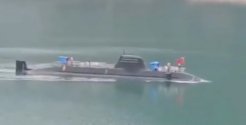@Bltizo, point taken about the Virginias. I guess the stars were uncharacteristically aligned for the Pentagon on that one.
A lot of the action for the foreseeable future is going to be within the First Island Chain, so there'll be a role for SSKs - especially SSKs that can move faster for longer than the present AIP types can.
I know you think it's premature to speculate on the capability of the 09-V, and tphuang dismisses that it could be world class outright, but I take the analogy of the 055 seriously. I see the exact same pattern the PLAN adopted with its destroyers, with the current panoply of 09-III variants mirroring the 052 variants. Earlier 09-IIIs explored technologies like natural circulation, etc. while this recently pictured one might have a shrouded propulsor (the picture quality is too poor to tell) and further advancements that aren't visible (perhaps IEP).
A thing that bothers me with Chinese nuclear submarines is that they use LEU. I have no expertise in nuclear engineering, but it seems evident to me that a HEU plant with the same power output would be smaller.
Nevertheless, China operates a large fleet of diesel submarines and it's not going to trade them all in for SSNs. Upgrading most of them to the most advanced 039 standard and installing new technologies like lithium batteries seems a no-brainer. The batteries especially will give them much more endurance than they previously had. I believe there were rumours going around for a while that the PLAN explored using small nuclear reactors on SSK-sized submarines, do you know what became of that?Diesel submarines should be better viewed as the 056/A equivalent, because expecting them to operate with any sort of competitive or realistic endurance outside of the first island chain from their homeports, would give up their few advantages of being SSKs, while exposing their disadvantages.
A lot of the action for the foreseeable future is going to be within the First Island Chain, so there'll be a role for SSKs - especially SSKs that can move faster for longer than the present AIP types can.
I know you think it's premature to speculate on the capability of the 09-V, and tphuang dismisses that it could be world class outright, but I take the analogy of the 055 seriously. I see the exact same pattern the PLAN adopted with its destroyers, with the current panoply of 09-III variants mirroring the 052 variants. Earlier 09-IIIs explored technologies like natural circulation, etc. while this recently pictured one might have a shrouded propulsor (the picture quality is too poor to tell) and further advancements that aren't visible (perhaps IEP).
A thing that bothers me with Chinese nuclear submarines is that they use LEU. I have no expertise in nuclear engineering, but it seems evident to me that a HEU plant with the same power output would be smaller.


